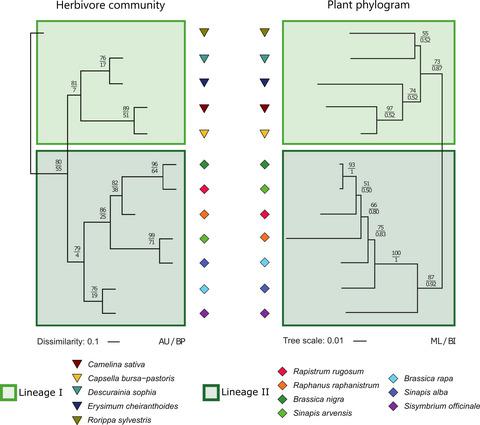当前位置:
X-MOL 学术
›
Ecol. Lett.
›
论文详情
Our official English website, www.x-mol.net, welcomes your
feedback! (Note: you will need to create a separate account there.)
Intraspecific variation in plant-associated herbivore communities is phylogenetically structured in Brassicaceae
Ecology Letters ( IF 7.6 ) Pub Date : 2021-07-30 , DOI: 10.1111/ele.13852 Daan Mertens 1 , Klaas Bouwmeester 2 , Erik H Poelman 1
Ecology Letters ( IF 7.6 ) Pub Date : 2021-07-30 , DOI: 10.1111/ele.13852 Daan Mertens 1 , Klaas Bouwmeester 2 , Erik H Poelman 1
Affiliation

|
As a result of co-evolution between plants and herbivores, related plants often interact with similar herbivore communities. Variation in plant–herbivore interactions is determined by variation in underlying functional traits and by ecological and stochastic processes. Hence, typically, only a subset of possible interactions is realised on individual plants. We show that insect herbivore communities assembling on individual plants are structured by plant phylogeny among 12 species in two phylogenetic lineages of Brassicaceae. This community sorting to plant phylogeny was retained when splitting the community according to herbivore feeding guilds. Relative abundance of herbivores as well as the size of the community structured community dissimilarity among plant species. Importantly, the amount of intraspecific variation in realised plant–herbivore interactions is also phylogenetically structured. We argue that variability in realised interactions that are not directly structured by plant traits is ecologically relevant and must be considered in the evolution of plant defences.
中文翻译:

植物相关食草动物群落的种内变异是十字花科植物的系统发育结构
由于植物和食草动物之间的共同进化,相关植物经常与相似的食草动物群落相互作用。植物-草食动物相互作用的变化取决于潜在功能性状的变化以及生态和随机过程。因此,通常,在单个植物上仅实现了可能的相互作用的一个子集。我们表明,聚集在单个植物上的昆虫食草动物群落是由十字花科两个系统发育谱系中的 12 个物种中的植物系统发育构成的。当根据草食动物饲养行会分裂群落时,保留了这种对植物系统发育的群落分类。食草动物的相对丰度以及群落的大小构成了植物物种之间的群落差异。重要的,已实现的植物-草食动物相互作用中的种内变异量也是系统发育结构的。我们认为,不直接由植物性状构成的已实现相互作用的可变性与生态相关,必须在植物防御的进化中加以考虑。
更新日期:2021-10-08
中文翻译:

植物相关食草动物群落的种内变异是十字花科植物的系统发育结构
由于植物和食草动物之间的共同进化,相关植物经常与相似的食草动物群落相互作用。植物-草食动物相互作用的变化取决于潜在功能性状的变化以及生态和随机过程。因此,通常,在单个植物上仅实现了可能的相互作用的一个子集。我们表明,聚集在单个植物上的昆虫食草动物群落是由十字花科两个系统发育谱系中的 12 个物种中的植物系统发育构成的。当根据草食动物饲养行会分裂群落时,保留了这种对植物系统发育的群落分类。食草动物的相对丰度以及群落的大小构成了植物物种之间的群落差异。重要的,已实现的植物-草食动物相互作用中的种内变异量也是系统发育结构的。我们认为,不直接由植物性状构成的已实现相互作用的可变性与生态相关,必须在植物防御的进化中加以考虑。











































 京公网安备 11010802027423号
京公网安备 11010802027423号